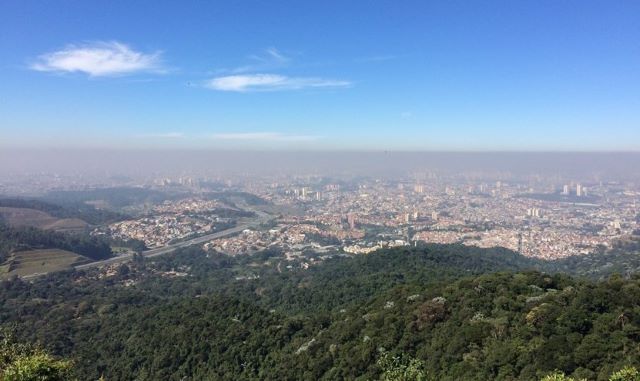


São Paulo city seen from Pico do Jaraguá, its highest point, on a day of temperature inversion during winter. Blue sky contrasts with dense pollution near ground level (photo: Regina Maura de Miranda/USP)
Published on 12/18/2023
By José Tadeu Arantes | Agência FAPESP – People who live in São Paulo city in Brazil certainly recall an event that occurred on August 19, 2019, when dark clouds covered the sky and day turned into night. The phenomenon was not caused by local pollution or emissions produced in São Paulo state but by a massive influx of particulate matter disgorged by forest fires blazing thousands of kilometers away in the Amazon. The murk made the interconnectedness of everything clear, if it was not already, showing that events in a remote area of the planet can have tenebrous consequences in a major population center.
Independently of such extreme events, air quality in the southern hemisphere’s largest city falls far below the standards set by CETESB, São Paulo state’s environmental agency, let alone the recommendations of the World Health Organization (WHO), which are more rigorous, as noted by Regina Maura de Miranda, a researcher and professor at the University of São Paulo’s School of Arts, Sciences and Humanities (EACH-USP). Miranda is last author of an article published in the journal Atmosphere on a study of air pollution in metropolitan São Paulo between July 2019 and August 2020, a period that included winter in both years.
“The study focused on particulate matter. We found that the situation tends to worsen in the winter months, when biomass burning is widespread in the interior of the state, in other parts of Brazil and even in other countries, such as Bolivia and Paraguay. Atmospheric circulation conditions may propel the smoke and particulate matter to São Paulo city, where it can descend nearly to ground level. At these times, fine particles contribute most because they interact particularly strongly with solar radiation, intensifying its effect on the climate and human health,” Miranda said.
The study characterized fine particulate matter, known as PM2.5 because it consists of particles with a diameter of less than 2.5 micrometers, and analyzed chemical composition data obtained at the surface in relation to optical parameters observed in the atmospheric column. Measurements were taken every 60 seconds, and daily averages was calculated. According to the article, these exceeded the WHO’s air quality standard (15 µg/m3) on 75 days.
“Using an appropriate model to analyze the environmental data, we identified four main sources of aerosols: heavy vehicles [42%], soil dust plus local sources [38.7%], light vehicles [9.9%], and local sources [8.6%],” Miranda said. Local sources included industrial emissions, suburban burnings, fires elsewhere in the state, and more distant fires.
“During the dry season, especially July-October, biomass burning in central Brazil and the interior of São Paulo releases large amounts of gas and particles. Driven by turbulent processes created by fire into relatively high layers of the atmosphere, the gas and particles are wind-borne as far as metropolitan São Paulo, as evidenced by the phenomenon witnessed in August 2019.”
Vehicle emissions
Given the sources in the study area, Miranda emphasized the importance of black carbon, which consists mainly of carbon emitted by heavy-duty vehicles and biomass burning. This type of particulate matter is a human health hazard because of the damage it does to the respiratory system, but it also contributes locally to atmospheric warming – and therefore exacerbates the impact of global warming – because it absorbs solar radiation in the visible and near-infrared spectrum.
Brazil’s National Space Research Institute (INPE) detected 197,632 and 222,797 fire spots in 2019 and 2020 respectively.
“Our study area was the EACH-USP campus in the east of the city. The area has over 6 million inhabitants, many factories, and several arterial roads with heavy traffic. It also contains Brazil’s largest airport. Asphalt makes much of the surface impervious, and other kinds of ground cover, alongside heat islands and high levels of pollutants, are part of the context. To characterize aerosol types and concentrations, as well as their chemical composition, optical properties and seasonal variability, the study was conducted in different seasons with both dry and rainy periods,” Miranda explained.
As for chemical composition, the study found high levels of soil-derived elements such as aluminum (Al), silicon (Si), calcium (Ca) and iron (Fe), but also detected anthropogenic elements emitted by human activity, such as sulfur (S) resulting mainly from combustion; bromine (Br) and calcium (Ca) used in lubricants and additives for light vehicles; copper (Cu) and zinc (Zn) used as anti-oxidants in engine oil; potassium (K) from biomass burning; and chlorine (Cl) from burning of household waste that includes plastic.
“The period we studied was atypical in a way, because emissions of pollutants fell sharply at the height of the pandemic. Nevertheless, the WHO’s recommendations were exceeded. In our next article, we plan to publish the data collected for the ensuing years and advance the investigation by analyzing secondary aerosols produced by chemical reactions of primary pollutants in the atmosphere,” Miranda said.
The study was part of the master’s research of Erick Vinícius Ramos Vieira, first author of the article, with Miranda as thesis advisor, and was supported by FAPESP via a research grant awarded to Miranda.
The article “Chemical characterization and optical properties of the aerosol in São Paulo, Brazil” is at: www.mdpi.com/2073-4433/14/9/1460.
Source: https://agencia.fapesp.br/50502